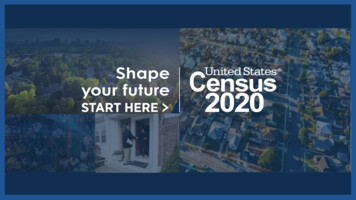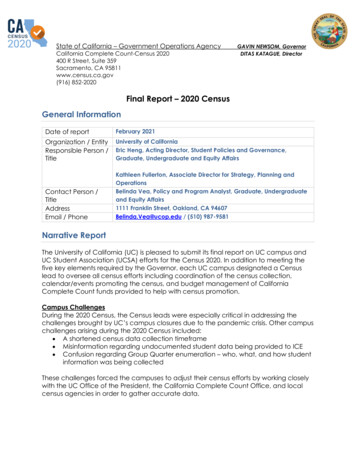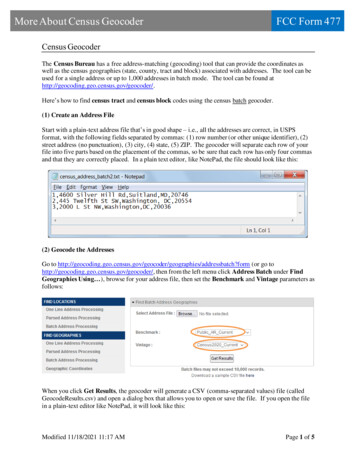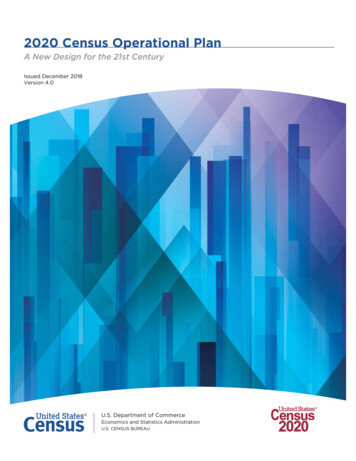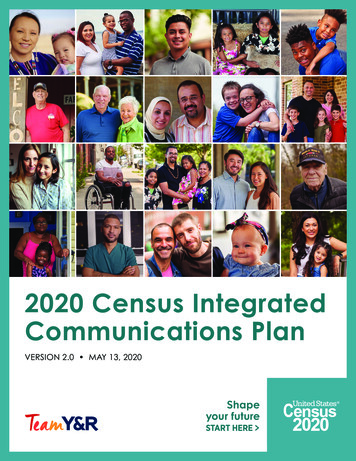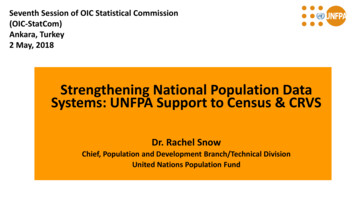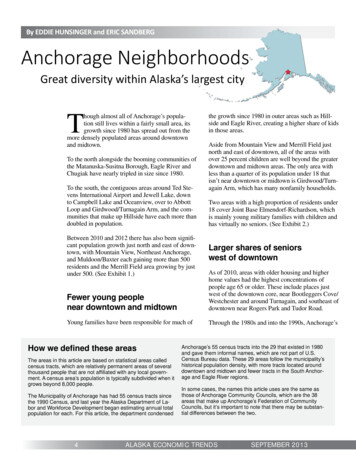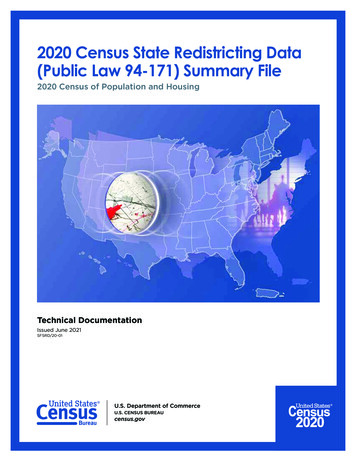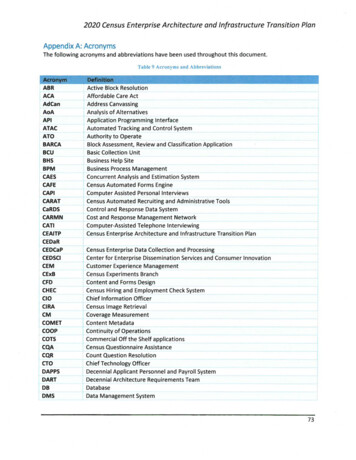
Transcription
2020 Census Enterprise Architecture and Infrastructure Transition PlanAppendix A: AcronymsThe following acronyms and abbreviations have been used throughout this document.Table 9 Acronyms and AbbreviationsAcronDefinitionABRACAAdCanActive Block ResolutionAffordable Care ActAddress CanvassingAnalysis of AlternativesApplication Programming InterfaceAutomated Tracking and Control SystemAuthority to OperateBlock Assessment, Review and Classification ApplicationBasic Collection UnitBusiness Help SiteBusiness Process ManagementConcurrent Analysis and Estimation SystemCensus Automated Forms EngineComputer Assisted Personal InterviewsCensus Automated Recruiting and Administrative ToolsControl and Response Data SystemCost and Response Management NetworkComputer-Assisted Telephone InterviewingCensus Enterprise Architecture and Infrastructure Transition IOCIRACMCOMETCOOPCOTSCQACQRCTODAPPSDARTDBOMSCensus Enterprise Data Collection and ProcessingCenter for Enterprise Dissemination Services and Consumer InnovationCustomer Experience ManagementCensus Experiments BranchContent and Forms DesignCensus Hiring and Employment Check SystemChief Information OfficerCensus Image RetrievalCoverage Measurementi Content MetadataContinuity of OperationsCommercial Off the Shelf applicationsCensus Questionnaire AssistanceCount Question ResolutionChief Technology OfficerDecennial Applicant Personnel and Payroll SystemDecennial Architecture Requirements TeamDatabaseData Management System73
2020 Census Enterprise Architecture and Infrastructure Transition PlanDefinitionDOCOSSOI OSSO (ARMS)EDITEEDMERPESBESDLCETLFIPSFISMAFTPI FPOFYGEOGEO ALMSLUCAMAFMAF/TIGERI MCMMCSMESMFTMMDCMOCSMOJOMTDBNCTIDepartment of CommerceDecennial Statistical Studies DivisionDecennial Statistical Studies Division (Administrative Records Modeling System)Enterprise Development, Integration, and Test EnvironmentEnterprise Data ModelEnterprise Resource PlanningEnterprise Service Bus1Enterprise System Development Life CycleEnumeration at Transitory Locations Field OperationFederal Information Processing Standards {FIPS)Federal Information Security Management ActFile Transfer ProtocolForms Printing and DistributionFiscal YearGeography DivisionGeography Div. (Real Time Non-ID Processing)1 Geographic Information SystemsGlobal Positioning SystemGroup QuartersHuman ResourcesHousing UnitIntegrated Capture and Data EntryInterface Control DocumentIdentity Management SystemInformation Exchange Package DocumentationIMB Postal Tracking System (barcode)Internet Self-ResponseInformation Technology1Information Technology Infrastructure LibraryListing and Mapping ApplicationLearning Management SystemLocal Update of Census AddressesMaster Address FileMaster Address File I Topologically Integrated Geographic Encoding and ReferencingSystemMobile Case ManagementMaster Control System: Mission Enabling System' Manage File TransferMulti-Mode Data CollectionMulti-Mode Operational Control SystemMOJO OCS (Operational Control System)MAF/TIGER databaseNational Content Test74
2020 Census Enterprise Architecture and Infrastructure Transition T&ERCCRDPRIRMFRPSSDLCSLCSMa EDDefinitionNational Information Exchange ModelNational Institute of Science and TechnologyNational Processing CenterNonresponse FollowupOptical Character RecognitionOperational Control SystemOffice of Information SecurityOracle Policy AutomationPrivacy Impact AssessmentPrivacy Threshold AnalysisQuality AssuranceQuality ControlRecruiting Assistant Time and ExpenseRegional Census CentersRed istricting Data ProgramRe-interviewRisk Management FrameworkResponse Processing SystemSystem Development Life CycleSurvey Life CycleSampling, Matching, Reviewing, and Coding SystemSubject Matter ExpertService Oriented ArchitectureStandard Economic Processing SystemTotal Cost of OwnershipTopologically Integrated Geographic Encoding and ReferencingThe Open Group Architecture FrameworkTelephone Questionnaire AssistanceTechnical Reference ModelUnited StatesUnited States Postal ServiceUnified Tracking SystemWork Breakdown StructureWeb- based Field Representative Earning Data75
2020 Census Enterprise Architecture and Infrastructure Transition PlanAppendix B: GlossaryTable lO GlossaryTennAdministrative RecordsBusiness Rules rument Authoring SystemInstrument MetadataMetadataModeDeflnldonInformation from external sources (e.g., Internal Revenue Service, Social SecurityAdm inistration, and Departments of Motor Vehicles) used to help create theframe, augment existing frame information, and/or augment responseinformation.The operational processes (e.g., creation, testing) and management controls(e.g., change management) to manage business rules over their life cycle ascensus and survey needs evolve.A business operation, requiring people, processes and systems, tocomprehensively and accurately count (enumerate), and subsequently create acomprehensive, authoritative list of all known people, residential facilities ororganizational entities, and their attributes. Because of challenges inherent toenumerating a large population and their attributes, the enumeration effort mayidentify less than 100% of the population. The information collected during acensus is captured in a data repository and is considered a frame (i .e., the knownpopulation).The property that enables a system to continue operating properly in the eventof the failure of (or one or more faults within) some of its components.Refers to: the set of questions to be asked in a census or survey and itsassociated medium, e.g., a paper survey form, an online survey form, anelectronic Blaise form . Instruments include the predefined responseoptions/choices presented to the survey respondent, the skip pattern associatedwith specific survey questions (e.g., "if the response to question 5 is Yes, skipquestions 6 and 7"), and the metadata created by an Instrument AuthoringSystem. The Instrument is a source of metadata used by Census Bureau systemsto determine how to interpret and process survey questions and surveyresponses.System used to create an instrument, e.g., BlaiseInformation that describes the content of a census or survey questionnaire.Information that describes how to interpret and process survey responses.Data that describes or provides information about other data. In the context ofCensus Bureau data collection systems, this refers to information attributes thatdescribe or help to explain operational data collected, created, or otherwisemanaged during a census or survey. Metadata is particularly important wheninformation is being exchanged between systems; it enables the system that isreceiving information to correctly interpret and process that information.Examples of metadata include column headings in a table, and extensiblemarkup language (XML) tags. The COMET initiative is currently developing XM Lstandards to improve future interoperability between Census Bureau systems.A mode is comprised of three primary components: the method for contacting aReporting Unit ; the means of administering the Instrument or questionnaire; andthe medium of recording the response (e.g., paper). Examples of survey datacollection modes are telephone (CATI), face-to-face in person (CAPI), Internetself-response through Web-based forms, and mailed paper questionnaires{PAPI).76
2020 Census Enterprise Architecture and Infrastructure Transition PlanTennDeftnidonSystems that directly perform and manage survey data collection with a specific' Mode, during the Data Collection phase of a survey or census. Examples of; current Census Bureau Mode Level Operation Control Systems are WebCATI (forMode Level Operation Control telephone-interview mode), ROSCO for face-to-face personal-interview mode),Systemsand Centurion (PRIMUS) (for Internet self-response, using Internet-based Webforms). Sometimes paper mode systems are included in this category; theseinclude Paper Capture systems (iCADE), MailOut systems (DocuPrint), and PaperControl systems (ATAC).Class of systems that directly perform and manage data collection using paperMode Systemssurvey forms, Internet-based web forms, telephone interviews, and face-to-facepersonal interviewsData about the process of collected survey or census data; usually consideredadministrative data about the survey itself. Paradata is important for reportingon key census and survey performance indicators to monitor during the dataParadatacollection process to predict census or survey response success rates, and todetermine when and how to best intervene in the data collection process tomaximize data quality and cost effectiveness.Information received via a mode from a reporting unit or respondent. Mostoften the information is a response to a solicitation received by the reportingunit. Alternate types of responses include a question, inquiry, or assistanceResponserequest. Response information may be received in physical form (e.g., completedpaper response form, via a face-to-face interview, via an electronic submission(e.g., Internet self-response), and/or other means.Class of systems that process survey response data after data collection activitiesResponse Processing Systemsare concluded. Systems that perform data editing, coding, imputation andestimation, e.g., CaRDS.The result of applying selection criteria to a frame to select a random selection ofpeople, residential facilities, or organizational entities from the frame. A subsetSampleof a frame. A list of people, residential facilities, or organizational entities thatare to be surveyed.Sample SystemA system that selects the sample for a given survey from the frame.A business operation, requiring people, processes, and systems, to accuratelycount (enumerate), and determine the attributes of a subset of a universe (asdetermined via a census) through a data collection effort. Requires, as a startingpoint, creation of a sample. Requires a survey instrument.The largest administratively defined group of reporting units or targetrespondents for which data collection is to occur. The highest level at which dataSurveycollection status is reported for a group of reporting units. A collection ofreporting unit groups. May contain one, a few or many reporting unit groups,depending on the needs and preferences of a given census or survey.In the context of MOCS, the survey owner will determine the scope of thesurvey. For example, a monthly ACS panel could be considered a single survey.Alternatively, the 12 monthly ACS panels within a calendar year may also beconsidered a single survey.The complete, real-world population of all potential Reporting Units, (i.e.,people, residential facilities or organizational entities). The goal of a census is toUniverseenumerate this population and record their attributes in a data repository.However, because of challenges inherent to enumerating a large population and1 their attributes, the enumeration effort may identify a representative subset of77
2020 Census Enterprise Architecture and Infrastructure Transition PlanTermWorkloadDefinitionpopulation, or a Frame. Note that some surveys use the terms universe andframe interchangeably.A collection of reporting units or respondents that are part of the same reportingunit group and for which a data collection operation is to be performed via asingle mode. The unit of data collection work transmitted from an operationalcontrol system (e.g., MOCS) to an Interview Operation Control System (e.g.,MOJO).78
2020 Census Enterprise Architecture and Infrastructure Transition PlanAppendix C: ReferencesThe following documents were referenced in the preparation of this t ransition plan.Table 11 Census DocumentsDocument2020 Decennial Census IT Infrastructure Strategy and Roadmap (draft)2020 Census Architecture, Version 1.0, 1/7/20162020 Census Interface Catalog,2020 Census Operational Plan, Issued November 2015, Version 1.1Census Enterprise Data Collection and Processing (CEDCaP) Segment Architecture, Version 2.3,07/29/2015Census Enterprise Data Collection and Processing (CEDCaP)Transition Plan, Version 2.4, 01/19/2016Int egration and Implementation Plan (draft)US Census Bureau's Risk Management Framework Methodology, Version 3.7, 05/23/2013Table 12 Other DocumentsSupportlns DocumentUnkNIST Risk Management Framework,Special Publication 800-37, Rev.1, June 5,2014NIST Special Publication 800-37 Revision 179
c.ct by v 111 of lh« 2015 Tens 1nterf1ee Cltaloc.{UfCT) upot1HO.t1 Uf.Cl1' tr- IJ"wvt·:.irt r.i Ttnlic.c.-,;:U!lot: ,. .e:ful'KtlCns·nst unrte:rse .sc S iLopnttitoryProctss Pi per RtsponMSNPC sanner: Sun PiperPonst D tlIMCmfl ,IJ'Ml\aaR spon shs Dna05'"'3,.l .UfCTwitftClwct.,.( trolfiti 0I !CS Mdreu l!b!! Pi] ts C,PuncbOnSI,"'"'Mid Micha .,. ,f'MtMiofts,CM k·if'I P pm- Rupon.stIAutomottd i nd M1nual)-confs,ond P.ChKk-otn P1 rMall tntetnet ltWllmOnl, ., cardl, aftd,e-l!P.H.porue 1.:.utom t )Pkbpsr1aW c O-'!:::K-":f uI!UAA{fl ftwl1ru nctlOns1;,gI E ·-. R« Ne Mai Stltus l ftMa oi S:.atio S.fun t.S.nd Cont.ct fmlltst aof O. ,.ffe'r!!c'' 1-.jilan .J., functtOnSAc:ctss cohcte-dPaf'Mat ACCHS Colecttd., ,.,let Rirnr.s.
II Frame DevelopmentM AF/TIGER ' -, A107tl · (rig.t -S lf .7 Jltila :W) l'l2A Pnwcfe GfO produc:K"'-'-""" . 7- c.r- '-"«i\r'f ") .CnMn(P -addrCu! -. .lf#c". " 'atCARRAA.M M . daress, *ch Geocodfo addrt'\S. b.ltchJ f ·ncArchltE:c:turt"t,.,,Administrative RecordsOrrl.nNte for ct.ua c0Jec1t0n . . n.f:M tJ.a . M CSc. c-.1.addr sl'U'\ · S. .U.u1.1 . bl.,. ., . .,. ,, . Geo.lofau- .'t!bm.tp ""' · 'Ao--feM:j.tl-I.I 'I!iR,A,S ItIM·11IConduct AdAec rnodthntCr.-at ac:lipf11i1t 6"cn'""""'"""-MOOE CONTROLARMS (DSSDI I-a.WA,MW'- - - - - :A:--:.P;-;.R; -- - - - -[A.AR1,M j ,.-# · I M«-' ,. . ,. rNI tkN-F "·P."'1.c.uptOC s ngII r -lir4L Moli!(h aiddl'es'J., reott hmeGeoc:ode ddtn-. f t'Jil t ime · -" '· 'nll"lft.S. ,Ml. MJtch addreu, m1tnui.I procf'Ss1ng G t ilddrH ma nwtIRTNP-.;;ii1.f1JN t' '9-K ' NKfl'*"I\tandafdal!! & t.eotdtf coc.te. ' '' . .PfOVtde cont lK1 1nf0rmat1onA, M Vt UU' ll r J'Ulu:nJr f!;& Sample DesignI---· -- wTW.Cort-o -lfld P'O'lsir .Multi-mode Operation Control System, s -- -·c:aac. littw-mApply umphng nd str tlf'KateonAuame,.,t IJN'lf1'lot'ror1TYt rnaitma dd reue:sCr'"ate unive1!te Cre;iite .ind rNn.ll '* 'kload for ntcontKl R cht k·in, COl'e self·r H d»t1, andcore tt1umerahon response diWi Proc"s UM s al"d late retumsI NC9 wtf- s. unl"ltl"f:SeI !Oetem" foltoww·upu A#fJlv AdAec .nnrvct.ons and btNMu rules Cntale and mMl.JCe l"ICW'l-tt"SpanW ut'MW!tH CteM .wtd tnM\illgt wrotkload fu billch & clntUI reu& aeocod1n1J""'""'nc·--4-1- ·-o-II r·Data Products andDisseminationData Editing, Imputation, andEstimation.-r-t ,Coding@ ---I·- 1--- .- I:- - . --- -- PerfOf'tn aut.O"\itic codingPerf0tm maru tl cod1ns 4-- PARAOATA MANAGEMENTUnlt'H J tad.if'll Sf tf'l'fll ,,.StOl't'\to d-M·Con e and score QDMSO,,UM,,,.- -- RPr KCfiStO e-d'""' "\f' Pro accHS to 0 .lc:fm t0r Repo t on cost 1nd progttu datJ RtOOtt on fteLd actmt.tSIPWMCht -·- ::.;: --- LB'-P' ---- -P- J ·· !
J "'UUI """" \.di IVd::.::.111is I t:::.l - 1.0::11::.u::. Udy . U'3/UJ./ LUJ.O l.11 It: UI ou::.11 10:: ::.::. . U IU l lUI I "'I l.l lllt:l.lUI t:Frame Development-----,?020 c-- MPO .MAF/TIGER Oehntoate for data codect!'On Provi GCO product M.ltch tlldd!P' \Geocode add ress.- - 1::! -------1·Census Ody 09/01/ 2016line of Business SolutionArch t('(turC'31 -.6 20 .6 ' lBARCA1-20lt tt-"""4.,,. lnlf't'"Mt ve BC.U rev1e-.,BCU l rctelongA,Ms· ; 2'02 1.si.nion .:0141 c.r.- r.c lApi o A .""'"""" .,v th dl!.t, (QP'Ut\ 4.uiGeoJSON SoetviCe.,. H I!!- ', ., ., GAi RlS - A«ove 6CU re okitlOfl."!N. - .,,., -,,··ud,t v - tUta,. ,. · -· ·k.:t - --. · - J,1. ., . . . .r.- fll!" & An t. ,Uw - --.----------- · ----A,P----------------------- jC - [SI:tionIw:- - ----· ·---- IIMified Ttae "'& Consohdate and store P'r taRep rt on cost and progru. d1ta po t on f1e-4d NII.es 8"'-·-PARAOATA- - --·--- MANAGEMENT,IJIlJNonCLOCAP n trrbc J
ot Bu"" ''' Solul' "Arch itect ureFrame DevelopmentA,M - -Oilweate f if' ta cN !cttOnProv.do GEO p odun Matth aaat b3tc.h procn Geoc.ode add--ess., tNtch P'Ol"W\It-4.BARCAtnt efKf.1'1-f' f'CU rev.ewUCU l rac.11.1r'lglo----------------- -A- - -A.MI2 ItAdministrative Recordsc.,. ,.Ac1rve OCU uteonA. MI ·Mr l(.20 Hg' l All · """" """C . SMI- P lARSISEnhance'. 'idd":tssc c. .1--.·-Pfo.i-·dl' cont Kt 1n forrn.Mt0nIICONTROL,I.Ar.,.,.tt. . .,,) -O C H .Sample Design. . . . . ., ,.Cort ol arcl O.lt-1 -,i.t sw.o A-'""-ClOC.VWlS ln.lttlOf'IS-'- .S.f - 1f.t44! V'Ht aGaptf'tt dHCflR,A ST.Wt.loUU,. ,.,. . , I#- A.C - Conduct AdRK modelingho.I.-·-· Mau:ti dc:hen, rnM""IUal PfOC: ' IGeotode addrcn , manua l p!'OCe»4ngI el - " NS \.tTP. .,A·11.M - .,-'M CS.,rooE.,.-.:.o {IA2'l l ll7,.,, .,.GeoJSON ICt'GATRf J20l:iC.w.qpQ '-r.tond,.,.,,. CO,.,.Au&ft\Mt unNitr'\er ormat m.l1hn1 addresseiCreate uruvet-seMult1·modc Operations Control System Create 1nd man.ace d for rt' P()ftdent conua RKittvethedl·et1, «Wesetf-re ·· ·1natotef1"tUlnefatfO'\ ff'Spotl 'il!Gat Proc:eu UM'i ind i.te fe h.rris M11n.JP stlf·rnpgrn.e Ottermt'Ht foOow-11p us.sAppty Adt'tc inmuct1ons atld b\lsine» rukuC.Hte nd man.qe non-respc o-H unMne Crute and workJooKt for twitch &. clencal .addrturNtch.nc & poc.ochnawi.,A, R,P'JData Editing, Imputation, andEstimationData Products and DisseminationCodin& (OSSDII rform"utOtNltc .o dine rform m.tnuo1I cod.ngRSTIPARADATA MANAGEMENTuriftfdlr.-:tini "" 1Tabul -]r-----.C( SC I CoMrot afld MffOOnst on. Wi;:wnISh ttio f d"t t .Mlds&0te t.i Rf'OOt't Oft cost ftd proerff) dat1 Reoc tt on fietd KtMttesClJ 10PrO\'tdf KC.S' tu cuftectH ""'POMl!S" a(( 4 to fld.:Jtol fotrewltd'l a stS)R
c of Bi.\lnc s Soiutn.in/V chltect ur cIFrame DevelopmentllARCA.i.A,M1ntt fXtwe 8CUrev.ewllCU .,liil IOdteu. batch protbio!f\I""' .,.*"" l""I r 1 a0.-UolNc:Mtd.,. . X2011gr l. -En Pr "' " ontxt " ''tfOfm.M.D'I - ·-u jI[."'I Condvct - . modoLos Crtate acl1ptivit de1.cn.- A ,( -II- - . MOOE CONTROL,I - UOCAI'!Sample Design--- ----'.jwA IsII ----·Multl·mode Operations Control System-A.A,RinstructJOnsR,A,ST fA·l""9olAttl'f' t U W · W .,- 0 ( ." . .,. - - V.t '"","- , y. . ,tMM CSM.ttc.h ttddr . manv Pf M.hl 11GcuoOO . , tn.Jr ual proccs - ---- - - - - 0-1Allt · """"' . . .h . llc r-.-. .- · I. .,.addre-uA,M l."-··-·. --.-. -.PEARSlS GHISON KeGA.lll:ES · AclNf: 8CUfflOkltlOft'V"' A,MGeocode Mdrlr5&, batth PfOC:C!'\Wll7 .lOlOC.-'ln lo------ ---------- -A-- -- A,iwo.t fofdita co'JKt on"OW do Gro 1 odvcuIAdmin istrative RecordsC ·ol .,,., w 01' "'.,,""'""""'"" nd""'""''""'un.erseAu&me1ltf onNt rnoii1ling addrHIHCr "'1PlH1rvetWJICre.Jte ;md n\3 wortdoMS for r nt contxtRf' ' chedc-tr , cor" wtf-rnpoose diu -1nd (OretnumftJhon se«HtaPfoceu UAA's and l.tte relurm Miinapsetf., u Df:term.nt fotlow-uo cases Apply AdR« in truc.t10M nd bu s r u CrHlf' and m.a:na non·r ponsc unrvtfscw CrHt and manacie WC)c'tdoad for bitch & denc.al M:ldrtisrNtthtns a aeococ1in1A,R,Pl -··1-diting, Imputation, and . Est imationData Products and DisseminationI· -- ITab'!! IO.!!. - - lRST . .PARAOATA MANAGEMENT( "' rol !Hld ·t:rt\l,jt.ii;tld""'" .cl ttmI----' Storn r dat: Comolid.a:t Mf store Pilf lil, Rf'P(Hton cost and PfoCrtu dica Rf1)0rton fletd KtMtlle'S p1CEM Oa\hbc»rd Visu.il AnalytksR8RI'----· --·- Cfl SCI . .---- aoso Pf t \ totothoctt d r 'Wl1.Pr .actei\ to Polttdm forresearch "ld '(SIS
OUTREACH ANO MARKETING2020 Census RPO "' SY1itemsEJ'9f'Hf11'19 Olnd klleogr3kln (IA.2 1 2 . 102I l'. eceMU.I Atctlitaaufa . 2020 High.f.evetIstem jt A-Partnership Emef8ency NotificationMR ti"'1''t-" til O\ d : Partnership Porta lI.d.llaC - ContMl ddl IF'4-AddJ* ' Aft - AdMil\ t'Md'\ '*"I.IIPartnership FulfillmentI An;hlt9dtM ,.,. ,1M - 1" mwn.nt M :iHH1 llM - p U- -P - PMad.U.Ifll - sp '\W'dau\ - rnl)l#d.tta\f . l1J\d.t 1YA - Time & M1 dilt W - WtWUl:wd cb1.lIIUOCt.Pr·Non-ctOCAP ESB Jmedacext ServicesEnterprise Enabling IT Support ServicesFlnprprint Vendor(sli HRfl Iennia1ce centerCUIC-Capture s phone requests forenumerators IT related support Remedy - Support fieldenumerators with IT related tssues MOM - Mobile d evice managementRemote access to devices.l[ilil lntesrated lCCi:Sb Mana1M'lftlt Sysl:tmI.HUMAN CAPITAL MANAGEMENT· f""""1ency Notifu:ation Sy\tf'l'T'IHR mNotify field wor1 ers of e morge ncyEnl t tSN'lte Service BusITcII""' C' HUl'l'lan RHOUfC: l nfomwition Syst "1I-- ENTERPRISE ADMINISTRATIVESUPPORT SERVICESCreate contact file for ENSt"H ECCtnws li\rin& itld EmployrMflt ChKk' Employment suitability screeningProcess applicant fingerprints.Oecermill Accou"t MM1 ecMO\ SystemHR·Authenticate decennlal accounts Setup ext nal accoun tl5esl tol! S1rv1 esENTERPRISE PUBLICATION AND COPY SERVICES:::JsI"""- "'IsunnowerCENDOCSIj Asset tracking svstem.-·1
2020 Census Enterprise Architecture and Infrastructure Transition PlanAppendix I: 2020 Census Systems ListTable 13 System ListSystem NameLong NameSystem DescriptionATACAutomated Trackingand ControlATAC provides customer, employee, and workflowmanagement by automating the business and supportprocesses associated with customer support,communications, case assignment, case management,escalation, and closure. Tracks and controls datagenerated by the automated and manual paper check-inapplications, and manages and controls the formbatching process prior to the iCADE paper processingsystem. Can also be the source for providing reportingmetrics that can be used by management. Materialsinclude, but are not limited to: Address Listing Pages,Questionnaires, HU Continuation Forms, CorrectionalFacility Continuation Forms, and Maps. Currentlymaintained by the NPC IT staff.FUTURE PLANBARCABlock Assessment,Research andClassificationApplicationCAESConcurrent Analysisand EstimationSystemThis is a valid NPC-resident system; not intended to beused in 2020 but will be used in tests through 2016.BARCA is an interactive review tool, which supportsimagery review for In-Office Address Canvassing. Theinteractive review module allows staff to determinewhether a block has undergone growth (either address orspatial), or needs existing address or spatia l problems tobe fixed . BARCA maintains the review history and has areporting component.The other part of BARCA is the block-tracking database.BARCA will have Active Block Resolution (ABR) allowing itto be used alongside GATRES, see where the pins weredropped during the review phase, make spatial updatesto the MAF/TIGER database (MTDB), and prepare anMTDB address update output. One of the enhancementsto ABR will be to convert the tool from block to BasicCollection Unit (BCU) and migrate the completed blockreviews to BCU level.CAES will be an enterprise modeling platform that storesdata and uses it to execute statistical models in supportof survey flow processing, analysis, and control.86
2020 Census Enterprise Architecture and Infrastructure Transition PlanSystem NameLong NameCaRDS (Post)Control andResponse DataSystemCaRDS (Pre)Control andResponse DataSystemCBSCommerce BusinessSystem : JeffersonvilleActivity ReportingSystemCEDSCICenter for EnterpriseDisseminationServices andConsumer InnovationSystem Description· CaRDS (Post) provides:Universe determination for the Decennial,Post data collection response processing,Interfaces to MOCS and other external systems, and aterm data store.FUTURE PLANWill deliver a system that is the front and back door todata collection . The CaRDS will pull personal or businessdata from the Census Master Address File and send it toMOCS.CaRDS (Pre) provides:Universe determination for the Decennial,Post data collection response processing,Interfaces to MOCS and other external systems, and aterm data store.Introduced October 2015 .CBS collects and reports labor hours and costs for theactivities that NPC performs. Outputs weekly productionstatistics for time and attendance and monthly incentiveawards for NPC staff who work on production standardrelated tasks. FUTURE PLAN (CBS)Maybe modernized to a new system ; This is a system ofsystems; Per Cathy Ayoob, APMS is part of CBS until wemove to SunflowerCenter for Enterprise Dissemination Services andConsumer Innovation (CEDSCI) is an enterprise system; itsdiverse membership is also composed of technologists,scientists, and analysts from Decennial, Economic,Demographic, Communications, Research andMethodology, and other offices. Their challenge is tomodernize our technology platforms and leverageexisting innovations to provide a set of shareddissemination services that enable both Census staff andour data consumers to do more with the massive contentwe publish year round.Their process will be to rapidly prototype, test and deploythe transition steps necessary to move us from thecurrent arch itecture to a new permanent model. Theirgoal is to broaden and enhance the use of existingsystems and tools and to build new features that willintegrate across programs and surveys.CEDSCl's core principles in the Federal Digital Strategy are87
2020 Census Enterprise Architecture and Infrastructure Transition PlanSystem NameSystem DescriptionLong Namefounded upon on the working papers developed by theCensus Bureau's Data Dissemination Task ForceCEM: Customer ExperienceManagementCEM is a flexible & extensible platform that capturescustomer interactions from multiple data stores and ispresented via a visual analytics dashboard to createopportunities for a better understanding of patterns andtrends of customer experiences that can lead toactionable improvement plans, and establish a1framework and foundation for customer experience dataintegration. Completed Proof Of Concept in CAT Lab. Nowin Pilot Phase, i.e., deployment to a dev/test/prodenvironmentFUTURE PLAN:CENOOCSCEDaR will replace CEM and UTSCENDOCS is a Web-based system for requesting: Forms design services from Forms and MailManagement Branch. Publications and graphics services from PublicationsServices Branch. Printing services through commercial vendors (whichincludes CD-ROM replication).CExB (DSSD) provides Sampling Criteria, contactstrategies and sample for re-interviewManage 2020 experiments programFUTURE PLAN Will not be part of the 2020 Censusoperation.CHEC is an administrative system that automatesclearance processing of all personnel at Census BureauHeadquarters, the Bureau of Economic Analysis (BEA),The Regional Offices (RO's), the National ProcessingCenter (NPC), and two Computer Assisted TelephoneInterview (CATI) sites. Supports fingerprint processingwith the Federal Bureau of Investigation (FBI), the Officeof Personnel Management (OPM), the Department ofHomeland Security (DHS), the Office of Management andBudget (OMB) and the Department of Commerce (DOC) .Census DocumentSystemCExB (OSSO)CHECCensus Hiring andEmployment CheckSystem(Fingerprinting)CHRISCensus HumanResourcesInformation SystemCensus ImageRetrievalCIRA1CHRIS creates the contact file for ENSCIRA stores Decennial census images as well as raw andedited data and provides a user interface for reviewing88
2020 Census Enterprise Architecture and Infrastructure Transition PlanSystem NameLong NameSystem Descriptionthe images and data. Used for age match research atNPC; scanned images are stored hereCodingr1COMETContent MetadataSystemCommercialPrintingPublic Use PrintingCOMPASSCensus OperationsMobile Platform forAdaptive Servicesand SolutionsCount ReviewSystemCoding is an application to perform manual coding of theresponse data, transforming data elements into standardcode.The COMET system develops a user interface for projectregistration and content entry, standardizes the contententry process and data elements for all modes of datacollections, develops a business process model includ inggovernance approval process for question content,delivery of metadata and business rules to MOCS for eachmode of data collection; and provides record layoutfunctionality.Census Automated Forms Engine (CAFE) is part ofCOMET.Deployed its first release in July 2015.Commercial Printing will print and address internetinvitations, reminder cards, and questionnaire packages.Mail invitations, reminder cards, and questionnaire' packages.COMPASS is a mobile application, framework andplatform for supporting on-device, server componentsand interfaces for mobile data collection implementingenrollment services, authentication services, and thesecure management, collection, exchange, storage andprocessing of data. Also includes seamless integration ofall on-device functionality required by Enumeratorsincluding: manage, schedule, locate and navigate to andbetween assigned cases. Performs designated CAPI andrelated interviews associated with each assigned caseand provide other location services.FUTURE PLANReference th is as CEDCaP Enumeration System, which isTBD based on alternative analysis; WebFRED functionalityfor enumerators to enter their time and expensecurrently occurs here.Count Review System supports the Count Reviewoperation.: Note: According to the 2020 Operation Plan, DetailedPlann ing of this operation has not started.89
2020 Census Enterprise Architecture and Infrastructure Transition PlanSystem NameLong NameCoverageMeasurementCQA· CensusQuestionnaireAssistanceC-SHaRPSDAPPSCensus
Census Enterprise Data Collection and Processing (CEDCaP) Segment Architecture, Version 2.3, 07/29/2015 Census Enterprise Data Collection and Processing (CEDCaP)Transition Plan, Version 2.4, 01/19/2016 Integration and Implementation Plan (draft) US Census Bureau's Risk Management Framework Methodology, Version 3.7, 05/23/2013
